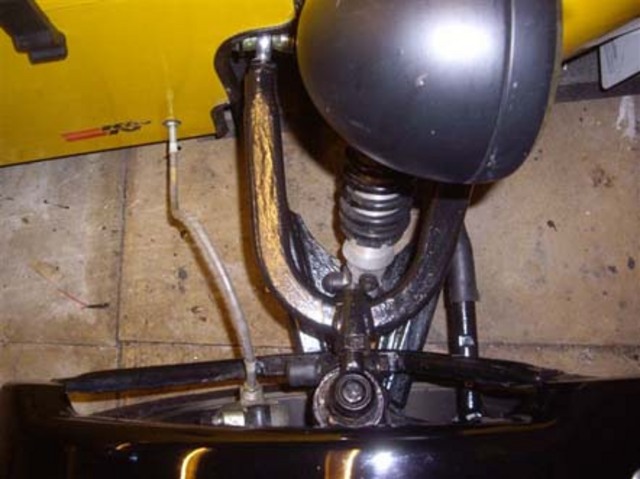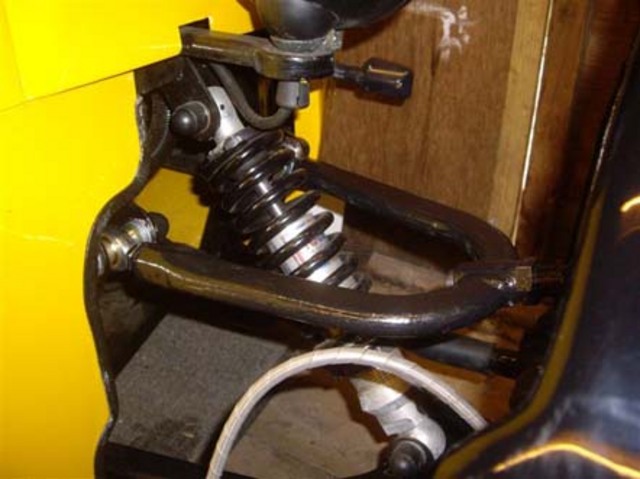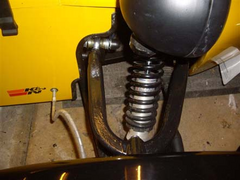whitestu
|
| posted on 17/5/10 at 07:18 AM |

|
|
Suspension geometry - I'm Confused!
I've been mucking about with the top wishbones on my Indy to improve steering feel and self centreing.
I have modified the bones so they have rose joints that allow for castor to be adjusted, and have set it up with 5-6 degrees of castor on each side
[was 3-4 as standard]. Toe in neg camber are both set at 1 degree.
I drove it with the new bones on Sunday and there isn't any difference as far as I can tell in self centreing or feel.
However, when reversing out of a parking space I noticed that is self centres strongly when going backwards!
If positive castor [top ball jount behind bottom ball joint] gives self centreing, how come it does it going backwards when it effectively has
negative caster?
I'm going to adjust the castor again to give 7-8 degrees, but am now doubting I'm doing the right thing!
Thanks
Stu
|
|
|
|
|
Ben_Copeland
|
| posted on 17/5/10 at 07:43 AM |

|
|
Sounds like you've either not got enough castor or you've pushed the top joint forwards instead of backwards... Top wishbones right way
round???
Mine did that on sva, spun wishbones round and it was ok
Ben
Locost Map on Google Maps
Z20LET Astra Turbo, into a Haynes
Roadster
Enter Your Details Here
http://www.facebook.com/EquinoxProducts for all your bodywork needs!
|
|
|
ReMan
|
| posted on 17/5/10 at 07:44 AM |

|
|
Are you sure that your steering, rack and joints are not overly tight.
AFAIK the castor will work in forward and reverse, it will actually have a stronger effect in reverse
|
|
|
whitestu
|
| posted on 17/5/10 at 08:14 AM |

|
|
quote:
Sounds like you've either not got enough castor or you've pushed the top joint forwards instead of backwards... Top wishbones right way
round???
They have definetely been moved the right way. I'm measuring the castor as 5.5 degrees.
Fairly sure the bones are on the right way round:
 
wb3
quote:
Are you sure that your steering, rack and joints are not overly tight
The joints move freely and I can easily turn the steering by hand by pulling on the wheels.
Other pics:
 
wb2
 
wb1
Stu
|
|
|
Ben_Copeland
|
| posted on 17/5/10 at 08:51 AM |

|
|
I had to put about 7 degrees castor to get through sva
Ben
Locost Map on Google Maps
Z20LET Astra Turbo, into a Haynes
Roadster
Enter Your Details Here
http://www.facebook.com/EquinoxProducts for all your bodywork needs!
|
|
|
whitestu
|
| posted on 17/5/10 at 10:09 AM |

|
|
quote:
I had to put about 7 degrees castor to get through sva
I'll be adusting it to get about 7 degrees as my next attempt! What I can't understand is why it centres really well in reverse with what
is effectively 5.5 degrees of negative castor!
Stu
[Edited on 17/5/10 by whitestu]
|
|
|
Frosty
|
| posted on 17/5/10 at 10:19 AM |

|
|
1 degree of toe in is loads. I wonder if this could be part of the problem?
I would have thought 20 minutes of toe is the most you would want to be running. Also have you tried toe-out instead of toe-in?
I was able to get my Westfield to self-center reasonably well with 3 deg of caster and loads of toe out. This was just for SVA though. Self centering
is pretty poor now.
|
|
|
whitestu
|
| posted on 17/5/10 at 10:27 AM |

|
|
quote:
1 degree of toe in is loads. I wonder if this could be part of the problem?
Could be - I'll set it parallel and see what happens. Not sure about toe out. I thought that tended to reduce straight line stability?
Stu
|
|
|
40inches
|
| posted on 17/5/10 at 10:34 AM |

|
|
quote:
Originally posted by whitestu
Not sure about toe out. I thought that tended to reduce straight line stability?
Stu
It does, after IVA it is changed back to neutral/toe in.
|
|
|
whitestu
|
| posted on 17/5/10 at 10:39 AM |

|
|
quote:
It does, after IVA it is changed back to neutral/toe in.
Cheers - I'm not doing this for IVA - I'm trying to make the car better.
|
|
|
Frosty
|
| posted on 17/5/10 at 10:39 AM |

|
|
quote:
Originally posted by whitestu
quote:
1 degree of toe in is loads. I wonder if this could be part of the problem?
Could be - I'll set it parallel and see what happens. Not sure about toe out. I thought that tended to reduce straight line stability?
Stu
IMO parallel is the worst of all since it leaves you with a numb reaction from the wheel before anything happens.
I favour toe-out over toe-in. High speed stability is not such an issue since these cars rarely see more than about 130mph. Toe out gives you a really
crisp turn-in though, so I run toe-out all the time on my car.
Give it a go and see what you think. It will probably improve your self centering too.
|
|
|
whitestu
|
| posted on 17/5/10 at 11:05 AM |

|
|
OK - I was thinking about stability at motorway speeds.
I'll adjust toe first then try some more caster if needed.
stu
|
|
|
britishtrident
|
| posted on 17/5/10 at 11:47 AM |

|
|
quote:
Originally posted by Frosty
quote:
Originally posted by whitestu
quote:
1 degree of toe in is loads. I wonder if this could be part of the problem?
Could be - I'll set it parallel and see what happens. Not sure about toe out. I thought that tended to reduce straight line stability?
Stu
IMO parallel is the worst of all since it leaves you with a numb reaction from the wheel before anything happens.
I favour toe-out over toe-in. High speed stability is not such an issue since these cars rarely see more than about 130mph. Toe out gives you a really
crisp turn-in though, so I run toe-out all the time on my car.
Give it a go and see what you think. It will probably improve your self centering too.
How you define high speed is a bit different from rest of us
Toe-out is lethal on a road car.
|
|
|
Frosty
|
| posted on 17/5/10 at 01:06 PM |

|
|
quote:
Originally posted by britishtridentHow you define high speed is a bit different from rest of us
Toe-out is lethal on a road car.
A bit of an overstatement I think. Why do you think toe out is lethal?
On a "road car" as in something you might pop to the shops and pick the kids up in, sharp turn-in is not too important, but on a 7
chassis, where the driving will always be spirited, I have found toe out to give much better response from the steering.
Is it bump steer you are worried about with toe out?
|
|
|
RazMan
|
| posted on 17/5/10 at 01:16 PM |

|
|
As a general rule, toe-in for the road and (slight) toe-out for the track.
I would have thought about 4 degrees castor is about right - any more and you might suffer with heavier steering
Cheers,
Raz
When thinking outside the box doesn't work any more, it's time to build a new box
|
|
|
Brommers
|
| posted on 17/5/10 at 01:33 PM |

|
|
quote:
Originally posted by britishtrident
How you define high speed is a bit different from rest of us
Toe-out is lethal on a road car.
In that case, I've been dead for the last, ooo, 10 years. Strange no-one's noticed...
[Edited on 17/5/10 by Brommers]
|
|
|
Steve Hignett
|
| posted on 17/5/10 at 07:45 PM |

|
|
I assume that the people (FROSTY and Brommers) that are stating that toe out is the only way to go, have bothered to check that the components that
are being used are the same???
Because (just for example) If toe out was preferred on Cortina uprights, but toe in preferred on Sierra, and someone was to stupidly state that it HAS
TO BE THIS WAY etc. Then I would see that as quite irresponsible and potentially dagerous in itself...
Mind you, this is just my humble opinion, you could well have checked these things, and I should prob keep my nose out.................
|
|
|
britishtrident
|
| posted on 17/5/10 at 07:58 PM |

|
|
Tyre pressures have a big effect on self centering
Castor dosen't really give true self centering.
KPI generates true self-centering --- but Cortina uprights don't allow much KPI.
[Edited on 17/5/10 by britishtrident]
[I] “ What use our work, Bennet, if we cannot care for those we love? .”
― From BBC TV/Amazon's Ripper Street.
[/I]
|
|
|
whitestu
|
| posted on 17/5/10 at 08:30 PM |

|
|
quote:
Tyre pressures have a big effect on self centering
Castor dosen't really give true self centering.
KPI generates true self-centering --- but Cortina uprights don't allow much KPI.
Tyres are at 16psi, but 35 makes no major difference.
How much KPI do Sierra uprights have? Sierra's self centre OK so with enough castor shouldn't a locost do the same?
I really trying to get more feel to the steering as much as self centreing.
Thanks
Stu
|
|
|
procomp
|
| posted on 17/5/10 at 10:01 PM |

|
|
Hi
You need to get your head around the fact that Camber is affecting castor. The BIG problem with the MK is that there is no Design to the front
suspension. It has no camber gain during cornering in fact it has camber loss during cornering. So your heading in the wrong direction from the moment
you start to turn. You will need to effectively re position the chassis brackets to give ample camber gain to get any real benefit from the front
end.
And as stated by Steve Cortina and Sierra require different geometry setups to gain full advantage of whats to offer.
Cheers Matt
|
|
|
Frosty
|
| posted on 17/5/10 at 10:37 PM |

|
|
quote:
Originally posted by Steve Hignett
I assume that the people (FROSTY and Brommers) that are stating that toe out is the only way to go, have bothered to check that the components that
are being used are the same???
Because (just for example) If toe out was preferred on Cortina uprights, but toe in preferred on Sierra, and someone was to stupidly state that it HAS
TO BE THIS WAY etc. Then I would see that as quite irresponsible and potentially dagerous in itself...
Mind you, this is just my humble opinion, you could well have checked these things, and I should prob keep my nose out.................
Just to clear something up, at what point did I say that toe-out was the only way to go? I suggested that the OP tried toe-out instead. Naturally it
may work and it may not. Not only do different cars and components like different setups, but different drivers do too.
All I said was that I favour toe-out on the 7 chassis, but this of course assumes the car has half decent geometry design and the running gear is
working with the car and not against it.
Incidentally, a car running Cortina uprights should still be able to use toe-out without issues, but if loads of bump-steer is present as a result of
the uprights fitted to the car, running toe-in is only masking the problem. Stating that toe-out might be dangerous is only true because something
else is not right.
Let's not let this thread run too far off course though.
|
|
|
whitestu
|
| posted on 18/5/10 at 07:24 AM |

|
|
quote:
You need to get your head around the fact that Camber is affecting castor
Isn't that the wrong way round? i.e that castor affects camber [when the steering is turned].
How does camber affect castor?
Stu
|
|
|
David Jenkins
|
| posted on 18/5/10 at 07:38 AM |

|
|
I've set my front wheels parallel - I found toe-out too unpleasant (well, certainly not relaxing to drive - too twitchy). I find parallel gives
me a snappy turn-in, with good straight-line stability.
This is with Cortina uprights, for reference.
There's another factor that no-one's mentioned yet - does the car use rubber bushes, PU bushes, or rose joints? Mine uses rubber bushes,
so I would guess that my front geometry is changing very slightly as my speed increases. I'd guess that this would happen less with PU bushes,
and very little with rose joints. Is this a reasonable assumption?
|
|
|
britishtrident
|
| posted on 18/5/10 at 11:10 AM |

|
|
On a heavy 1970s car like the Cortina with radial tyres the weight of the car distorts the sidewalls of the tyres enough to generate a
"self aligning torque", this is one of the reasons they Cortina/Granada front end dosen't have much KPI or caster the self
centering is mainly generated by the tyres.
If you look at a 1950s style suspension like the MGB or Triumph Herald which were optimised for crossply tyres you will see a lot of KPI and caster.
[I] “ What use our work, Bennet, if we cannot care for those we love? .”
― From BBC TV/Amazon's Ripper Street.
[/I]
|
|
|
britishtrident
|
| posted on 18/5/10 at 11:15 AM |

|
|
quote:
Originally posted by David Jenkins
I've set my front wheels parallel - I found toe-out too unpleasant (well, certainly not relaxing to drive - too twitchy). I find parallel gives
me a snappy turn-in, with good straight-line stability.
This is with Cortina uprights, for reference.
There's another factor that no-one's mentioned yet - does the car use rubber bushes, PU bushes, or rose joints? Mine uses rubber bushes,
so I would guess that my front geometry is changing very slightly as my speed increases. I'd guess that this would happen less with PU bushes,
and very little with rose joints. Is this a reasonable assumption?
Yes I can't think of a single front engined rwd production car that manufacturers specifies a toe out --- quite a few are parallel with a
small + or - tolerance but most specify a very small toe-in.
In the old days with crossply tyres and lots of positive ackerman they used to specify quite large amounts of toe-in.
[I] “ What use our work, Bennet, if we cannot care for those we love? .”
― From BBC TV/Amazon's Ripper Street.
[/I]
|
|
|













